Energy Storage
Brian Cashion
Energy Storage
Accure Battery Intelligence
Energy Storage
Jim Brown

At the Advanced Clean Transportation (ACT) Expo, Hexagon Purus in partnership with Hino Trucks, proudly announces the launch of Tern, a dedicated zero-emission truck brand along with their inaugural vehicle model, the RC8, a groundbreaking battery electric Class 8 tractor tailored for the U.S. market. This innovative semi-tractor leverages Hexagon Purus' years of development of zero-emission drivetrains for heavy-duty trucks and represents a driver-preferred option for fleets that are electrifying practical routes.

A product of the new long-term agreement between Hexagon Purus and Hino Trucks, valued at up to approximately $2 billion, Tern is designed to deliver a seamless transition to electrification for the U.S. commercial vehicle sector. Manufactured in Hexagon Purus' new facility in Dallas, Texas, the Tern RC8 is scheduled for serial production in late 2024.
Built on Hino's proven XL Series 4x2 chassis and equipped with Hexagon Purus' cutting-edge zero-emission technology, Tern exemplifies innovation with its proprietary battery systems, auxiliary modules, and power modules. The vehicle leverages a U.S. assembled Hino chassis, an e-Axle from Dana for optimum efficiency, and battery cells supplied and manufactured by Panasonic Energy initially in Japan, before transitioning to De Soto, Kansas from 2026 onwards, ensuring reliability, American sourcing, and top-tier performance.
"Tern RC8 delivers the comfort, reliability and safety that drivers and fleets want, and it’s purpose-built to be a very practical truck for operators integrating zero-emission trucks into their fleets," said Morten Holum, CEO of Hexagon Purus. "We are excited to introduce a truck that embodies the endurance and efficiency of the Arctic Tern, renowned for its light weight and long migratory journey – a trusty companion you can always rely on."
Key features of the Tern RC8 include:
Tern trucks will be available exclusively through the Tern dealer network and will leverage Hino’s network ensuring total support and service. This launch aligns with the Advanced Clean Fleets regulation in California and gives fleets an excellent option to decarbonize their supply chain, especially in target applications like metro-regional routes, food & beverage logistics and similar routes where the tight turning radius and popular 4x2 chassis offer practical benefits.
“Our partnership with Hexagon Purus introduces a highly reliable Class 8, 4x2 tractor option into the electric truck market, catering to a wide range of applications. We are excited to see Tern launched in California, where fleet electrification is imperative,” remarked Glenn Ellis, President of Hino Trucks.
The introduction of the Tern brand signifies a transformative step for both companies and the commercial trucking industry, driving towards a zero-emission future without compromising on power or performance.
A press conference will be held at ACT Expo on Monday 20 May from 17.20-17.25 Pacific Time at Booth 2244 to unveil Tern RC8. Interviews with Hexagon Purus executives can be arranged at ACT Expo, with CEO Morten Holum and EVP Todd Sloan present. Glen Ellis, President of Hino Trucks, will also be available for interview directly after the press conference.
Tern | www.terntrucks.com
Hexagon Purus | www.hexagonpurus.com
Hino Trucks | http://www.hino.com

The Minnesota legislature passed the Minnesota Energy Infrastructure Permitting Act (SF 4784/HF 4700). This legislation is a robust package of reforms that will reduce permitting wait times for wind, solar, battery storage and transmission line projects and will provide an easier, more consistent and predictable process that will help establish a stable business environment for clean energy development in Minnesota.
“This legislation represents nearly a decade of hard work building partnerships with key groups and connecting the dots on why siting and permitting reform is pivotal to the success of Minnesota's clean energy goals,” said Beth Soholt, Executive Director, Clean Grid Alliance (CGA). “Siting and permitting is among the largest roadblocks to deploying renewable projects across the Midwest, and the reforms in this package ensure Minnesota’s policies demonstrate the state is committed to meeting the clean energy transition.
The Energy Infrastructure Permitting Act is the culmination of months of work this year and represents a comprehensive package of reforms developed by participants of the Public Utilities Commission Permitting Reform Stakeholder Group, which held several work group meetings last year to address this issue. “The collaboration of the permitting reform stakeholder group that generated the ideas in the legislation was an unprecedented and cross-cutting effort,” said CGA Regional Policy Director, Peder Mewis. “Passage of the permitting reform act helps bolster Minnesota’s national standing in renewable energy development. We thank Sen. Frentz, Rep. Acomb and Rep. Long for their leadership and perseverance in advancing these policies. We look forward to Governor Walz signing this important legislation into law.”
“CGA and the Laborers International Union of North America (LIUNA) have been united on permitting reform for many years. CGA believes that partnerships truly build power, and I could not be happier with this outcome and for our unwavering partnership,” Mewis added.
“This is great news. Renewable energy standards and carbon free goals can be important investment drivers. But without an efficient and cost-effective permitting process to go along with it, Minnesota is leaving affordable power, jobs and business opportunities on the table,” said Kevin Pranis, Marketing Manager, Laborers International Union of North America for MN & ND. “Skilled Laborers are ready to get to work so Minnesota can achieve our clean energy goals.”
Clean Grid Alliance | https://cleangridalliance.org/
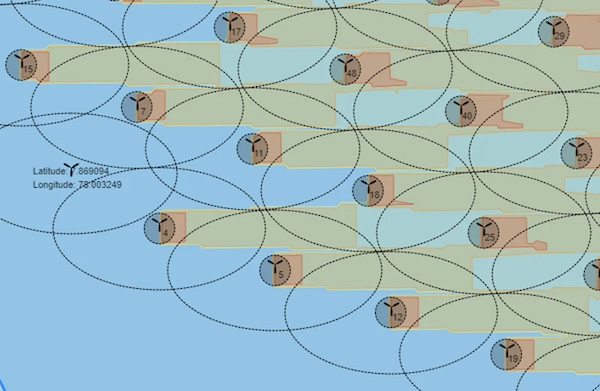
With the European offshore wind industry experiencing widespread delays to scheduled auctions, there is a pressing need for developers to closely manage the essential early stages of development to ensure the success of the next generation of projects and meet the goals of the EU 2030 Agenda.
Countries such as Spain, Portugal, and the Netherlands have already faced delays in their planned offshore wind auctions for this year, with few European auctions planned for H1 2024 proceeding on schedule.
Youwind Renewables, a leading provider of web-based solutions for optimizing early-stage offshore wind development, has warned that, in response to these delays, authorities are expected to push for shorter timelines, as it is suspected that the best-prepared development teams will be rewarded while and ensuring the goals of the EU 2030 Agenda are not at risk.
With the average time to prepare and submit a bid standing at approximately two to three years, the business has emphasised the importance of addressing key risks and potential bottlenecks quickly and early – identifying five key priorities for developers preparing to participate in upcoming auctions.
Stakeholder Engagement: Before delving into detailed park layout optimization, it is imperative for developers to engage with all stakeholders, including health and safety authorities, local communities, and environmental groups - as well as accounting for vessel density by ensuring oversight over fishing activities in the area. By considering stakeholder input from the outset, developers can navigate potential challenges more effectively and build stronger partnerships to support project development.
Logistics Planning: With vessel availability posing a significant challenge in the offshore wind sector, meticulous logistics planning is essential. According to maritime market intelligence firm Spinergie, the current shortage of heavy installation vessels may result in a global pipeline of fixed-bottom offshore wind projects, capable of quintupling operating capacity by 2030, achieving less than 60% of this potential. Developers must assess various options and anticipate the need to schedule construction activities outside of optimal weather windows to minimize delays and optimize project timelines.
Understanding Wake Effects: Factoring in wake effects is crucial, particularly in congested wind farm areas like those in the Netherlands, Germany, and Belgium. Developers must account not only for existing wind farms but also for future projects that could impact their operations throughout their operational lifespan. Countries like France, Spain and Portugal especially must take wake effects into account, with collaboration on future wind farm plans near West Galicia and the Porto area already underway.
Mitigating Cable Losses & Failures: Understanding the impact of electrical failures on future revenue is paramount. Cable failures affecting even a few turbines can result in substantial revenue losses. Developers must incorporate contingency plans to mitigate the financial implications of such failures and ensure project profitability.
Investment in Advanced Modelling: In the race to meet bid deadlines, success in securing projects increasingly hinges on Investing in advanced modelling capabilities. Increased multisource data processing power has become essential to effectively navigate evolving market conditions. Youwind's robust features have supported five auction-winning projects in Europe and APAC over the last three years, demonstrating its effectiveness in accelerating project development and enhancing competitiveness in the industry.
"As the offshore wind sector navigates a complex environment, and pressure increases on bid timelines, it is imperative for developers to proactively tackle known risks and bottlenecks from the early stages onwards – and to invest in the modelling capabilities that will enable them to do so,” said Anna Rivera, Co-Founder & CEO of Youwind. “Managing some of these critical risks, such as vessel availability, will ultimately make the difference between a project that is successful and one that fails to live up to its potential.”
Youwind | https://youwindrenewables.com/

JinkoSolar Holding Co., Ltd. (the "Company," or "JinkoSolar") (NYSE: JKS), one of the largest and most innovative solar module manufacturers in the world, announced that its 2000-Volt EAGLE Modules were the first in the world to be qualified as UL listed products for UL61730-1 and UL61730-2, and UL classified products for IEC 61215-1, IEC 61215-2 and IEC 61215-1-1.
JinkoSolar worked with UL Solutions to certify this new and high-quality module. Following certification, the 2000-Volt EAGLE Modules will be deployed selectively in the U.S. in the third quarter of 2024, with general U.S. market availability in 2025.
The 2000-Volt module increases string lengths for utility-scale projects, thus reducing the overall system level component costs and improving end-to-end efficiency with less energy loss. This enables a more competitive levelized cost of energy, and projects using JinkoSolar's modules will see higher return on investment. This is the latest advancement in high voltage solar certification since 1500-Volt modules first came onto the market eight years ago.
"We are always pleased to collaborate with industry innovators and technology leaders such as JinkoSolar," said Colleen O'Brien, Principal Engineer of UL Solutions. "UL Solutions is dedicated to elevating industry competitiveness through the exploration of cutting-edge technologies while prioritizing safety in their application."
"UL Solutions is synonymous with product safety and certification, so working with UL Solutions to achieve this 2000-Volt milestone was a natural choice," said Nigel Cockroft, General Manager of JinkoSolar (U.S.) Inc. "JinkoSolar's expertise lies not just in advanced R&D but also in bringing those technologies to scale and making them available cost-competitively to our U.S. customers. We look forward to the 2000-Volt EAGLE Modules making a tangible difference to our customers' bottom lines."
JinkoSolar | www.jinkosolar.com
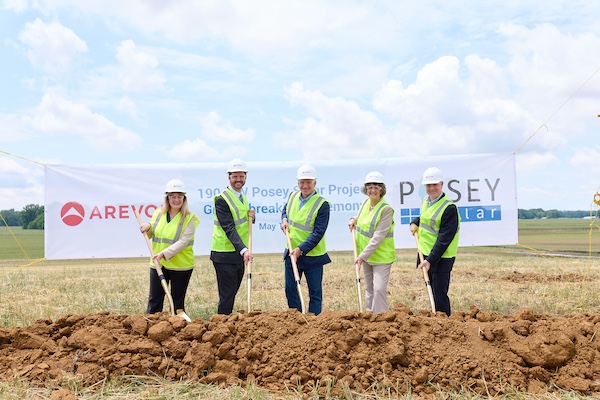
Arevon Energy Inc., a leading renewable energy developer, owner, and operator, along with CenterPoint Energy, Bechtel, participating landowners, and other distinguished guests joined together at a groundbreaking event to celebrate the construction of the 228 megawatt (MWdc) Posey Solar Project in Posey County, Indiana. Arevon developed Posey Solar in partnership with CenterPoint Energy, and Bechtel is the project’s engineering, procurement, and construction (EPC) contractor. Posey Solar is expected to become operational by mid-2025, and the clean energy generated by the project will be distributed to meet the energy needs of southwestern Indiana homes and businesses.
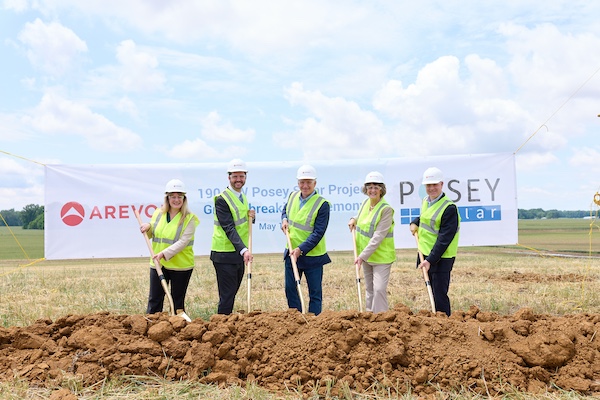
The Posey Solar Project groundbreaking event featured a welcome address, celebrating the commencement of Indiana’s newest solar project; networking and refreshments; and a symbolic groundbreaking moment where project partners, landowners, and esteemed guests ceremoniously marked the beginning of the project’s construction. Several speakers, including Kevin Smith, Chief Executive Officer at Arevon; Richard Leger, Senior Vice President, Indiana Electric at CenterPoint Energy; Ryan Hadley, Executive Director at the Indiana Office of Energy Development; and Connie Neininger, National Policy Advisor at the Center for Infrastructure & Economic Development also shared their insights on the project’s impact.
“Renewable energy, such as solar, supports the diversification of our state’s energy portfolio, decreases the tax burden on the county’s residents, provides economic benefits to the landowners, and improves the business environment for the county. Posey County, through the development of their balanced solar ordinance, encourages the development of renewable energy to support the future growth and viability of their rural community,” said Connie Neininger.
Arevon and CenterPoint Energy first announced their partnership for the Posey Solar Project in February 2021, and CenterPoint Energy received final approval from the Indiana Utility Regulatory Commission (IURC) in October 2023, to acquire the Posey Solar Project. CenterPoint Energy will be the long-term owner and will operate the project.
“We value the relationship built with Arevon as we continue through the process to construct and bring into service a renewable project that will further diversify CenterPoint Energy’s electric generation portfolio,” said Richard Leger. “We remain committed to being a good neighbor in the communities we serve and look forward to delivering environmentally sustainable energy to Posey County and our entire southwestern Indiana footprint through this project for years to come.”
During construction, Posey will create more than 200 full-time construction jobs and will have a multi-million-dollar budget to operate and maintain the project during its estimated 35-year lifespan. The project, which is slated to include a 20-acre pollinator garden within its footprint, will also contribute lease payments to Posey County landowners and more than $30 million to local governments over the life of the project. During the construction period, an estimated $31.2 million will be spent in Posey County, going toward hotels, restaurants, and other local businesses. Moreover, the Posey project has committed to contributions to the Marrs Township Fire Department over the life of the project and also contributed $219,000 toward new communications towers that will help ensure reliable radio service to first responders.
“Posey Solar provides significant benefits to the state of Indiana and to Posey County, including cost-effective renewable energy, substantial construction jobs, and long-term tax benefits to the region,” said Kevin Smith. “Arevon appreciates our partners and the stakeholders who made this project a reality, and we look forward to advancing the Posey Solar Project into operations.”
Arevon Energy | www.arevonenergy.com
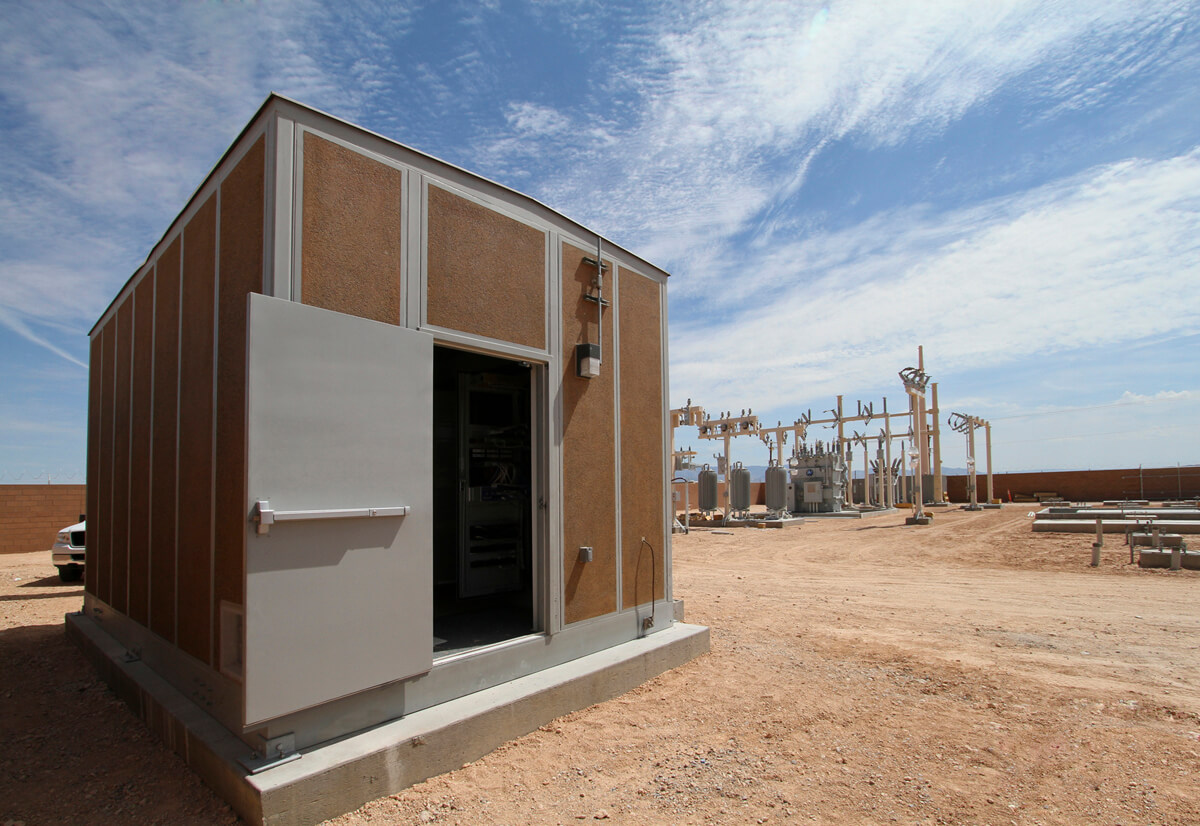
NeoVolta Inc., a San-Diego based leader in smart energy storage solutions, announces that Ardes Johnson, CEO of NeoVolta, Inc. was called as an expert witness to testify and advise the U.S. International Trade Commission in Washington, D.C. on protecting U.S. manufacturing against unfair trade practices, particularly in the renewable energy space.
The USITC is mandated by congress with broad investigative responsibilities on matters of trade. The agency investigates the effects of dumped and subsidized imports on domestic industries and conducts global safeguard investigations.
The Commission also adjudicates cases involving imports that allegedly infringe intellectual property rights. Through such proceedings, the agency facilitates a rules-based international trading system. His testimony will help promote advantageous US policy for companies like NeoVolta to develop product and manufacturing capabilities within the Country.
For more than a decade, Mr. Johnson has been considered an expert in renewable energy and is frequently called upon to represent the industry in the field of manufacturing and supply chain security. Johnson joined NeoVolta from Meyer Burger Americas, where, as President and General Manager, he spearheaded the company’s expansion in the Americas, achieving a multi-gigawatt backlog of over $1 billion dollars and is scaling to 2 gigawatts per year of manufacturing in just 18 months.
Prior to Meyer Burger, Johnson served as Director of Americas Sales and Marketing for Tesla’s Energy Products division. Johnson was instrumental in the development and success of Tesla’s energy storage solutions, where he launched the partner channel program for the PowerWall and PowerPack products in the Utility, Residential and Commercial Markets. His leadership helped secure a landmark 80 MWh storage contract with Southern California Edison.
Johnson, a U.S. Navy Veteran said: “Our goal is to position NeoVolta as a premier U.S. based manufacturer. Our strategy is to ensure that there is a level playing field in energy storage. Yes we have a global supply chain strategy, but we also understand the criticality of ensuring sustainable solutions that are created through jobs right here in the U.S.”
NeoVolta I www.neovolta.com

Vikram Solar, a frontrunner in India's solar module manufacturing, has secured a landmark 397.7 MWp module supply order for NTPC Renewable Energy Limited.
Vikram Solar's modules will power a significant portion of the massive 1,255 MW Khavda Solar Project in Gujarat. These cutting-edge bifacial DCR modules boast a minimum capacity of 540 Wp and meet the stringent ALMM standards.
This partnership not only propels India's solar energy ambitions but also underscores Vikram Solar's unwavering commitment to sustainability through high-performance solutions. The project aligns perfectly with the Domestic Content Requirement (DCR), further solidifying the company's dedication to bolstering India's domestic solar manufacturing capabilities.
Commenting on the notable achievement, Mr. Gyanesh Chaudhary, Chairman & Managing Director of Vikram Solar, remarked, “This landmark order is a powerful testament to the enduring partnership between Vikram Solar and NTPC Renewable Energy Limited. Our successful execution of numerous solar projects for NTPC has fostered a deep trust, built on a shared commitment to excellence. As a pioneer leading India's solar revolution, Vikram Solar remains unwavering in its pursuit of innovation and quality, always prioritizing our customers' needs. This collaboration not only cements our industry leadership but also aligns perfectly with our vision to propel India towards a clean energy future. We look forward to making substantial contributions to the renewable energy sector, helping India become a global leader in sustainable practices”.
Vikram Solar takes the helm of manufacturing high-efficiency solar modules critical to the Khavda Solar Project's success.
Vikram Solar | www.vikramsolar.com

Alternative Energies Jun 26, 2023
Unleashing trillions of dollars for a resilient energy future is within our grasp — if we can successfully navigate investment risk and project uncertainties. The money is there — so where are the projects? A cleaner and more secure energy ....
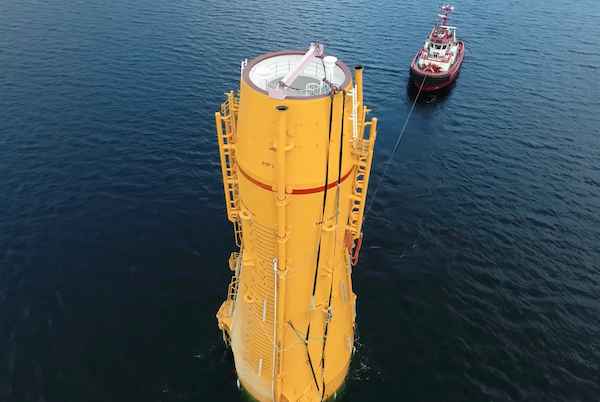
The Kincardine floating wind farm, located off the east coast of Scotland, was a landmark development: the first commercial-scale project of its kind in the UK sector. Therefore, it has been closely watched by the industry throughout its installation. With two of the turbines now having gone through heavy maintenance, it has also provided valuable lessons into the O&M processes of floating wind projects.
In late May, the second floating wind turbine from the five-turbine development arrived in the port of Massvlakte, Rotterdam, for maintenance. An Anchor Handling Tug Supply (AHTS)
vessel was used to deliver the KIN-02 turbine two weeks after a Platform Supply Vessel (PSV) and AHTS had worked to disconnect the turbine from the wind farm site. The towing vessel became the third vessel used in the operation.
This is not the first turbine disconnected from the site and towed for maintenance. In the summer of 2022, KIN-03 became the world’s first-ever floating wind turbine that required heavy maintenance (i.e. being disconnected and towed for repair). It was also towed from Scotland to Massvlakte.
Each of these operations has provided valuable lessons for the ever-watchful industry in how to navigate the complexities of heavy maintenance in floating wind as the market segment grows.

The heavy maintenance process
When one of Kincardine’s five floating 9.5 MW turbines (KIN-03) suffered a technical failure in May 2022, a major technical component needed to be replaced. The heavy maintenance strategy selected by the developer and the offshore contractors consisted in disconnecting and towing the turbine and its floater to Rotterdam for maintenance, followed by a return tow and re-connection. All of the infrastructure, such as crane and tower access, remained at the quay following the construction phase. (Note, the following analysis only covers KIN-03, as details of the second turbine operation are not yet available).
Comparing the net vessel days for both the maintenance and the installation campaigns at this project highlights how using a dedicated marine spread can positively impact operations.
For this first-ever operation, a total of 17.2 net vessel days were required during turbine reconnection—only a slight increase on the 14.6 net vessel days that were required for the first hook-up operation performed during the initial installation in 2021. However, it exceeds the average of eight net vessel days during installation. The marine spread used in the heavy maintenance operation differed from that used during installation. Due to this, it did not benefit from the learning curve and experience gained throughout the initial installation, which ultimately led to the lower average vessel days.
The array cable re-connection operation encountered a similar effect. The process was performed by one AHTS that spent 10 net vessel days on the operation. This compares to the installation campaign, where the array cable second-end pull-in lasted a maximum of 23.7 hours using a cable layer.
Overall, the turbine shutdown duration can be broken up as 14 days at the quay for maintenance, 52 days from turbine disconnection to turbine reconnection, and 94 days from disconnection to the end of post-reconnection activities.
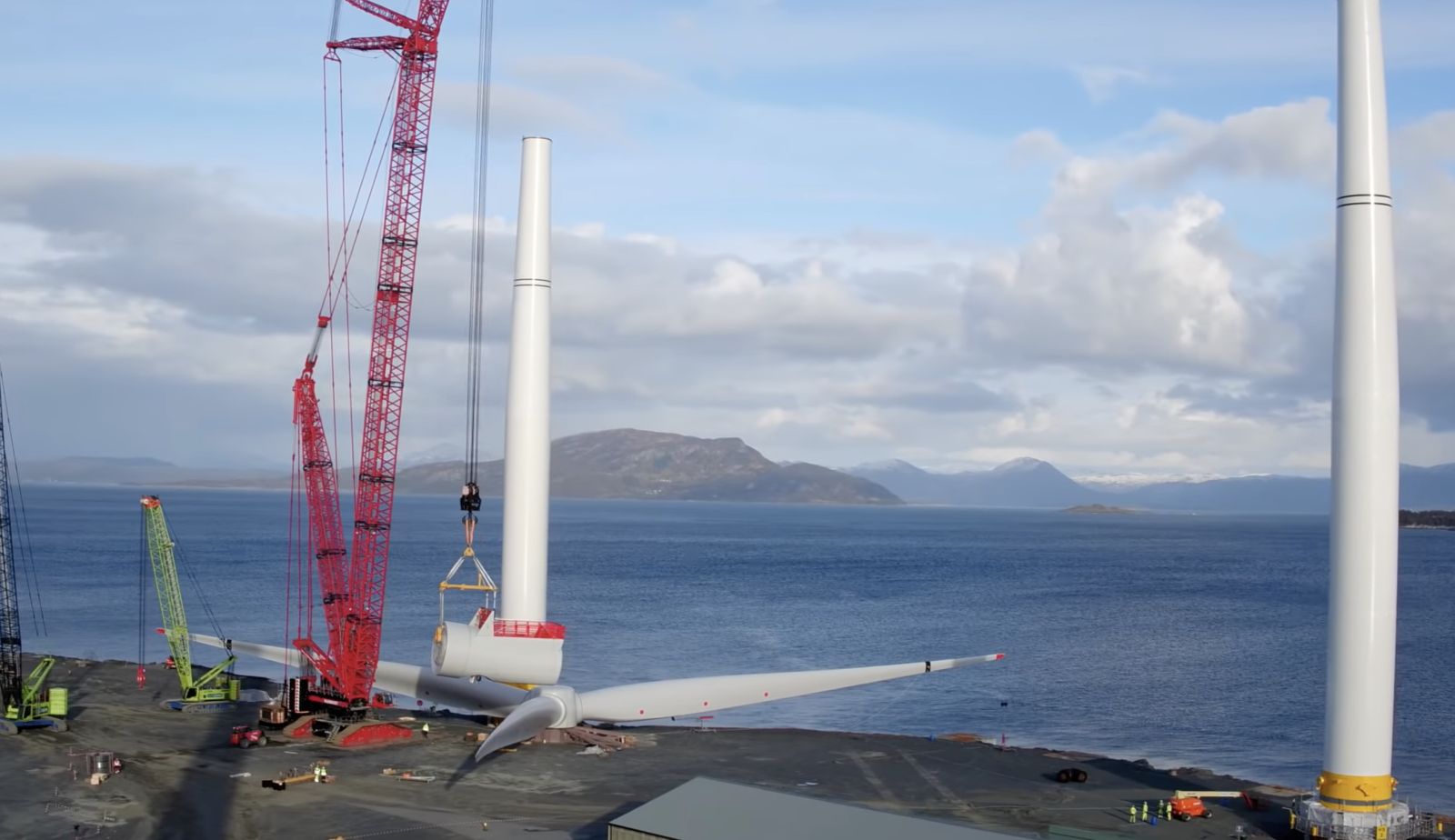
What developers should keep in mind for heavy maintenance operations
This analysis has uncovered two main lessons developers should consider when planning a floating wind project: the need to identify an appropriate O&M port, and to guarantee that a secure fleet is available.
Floating wind O&M operations require a port with both sufficient room and a deep-water quay. The port must also be equipped with a heavy crane with sufficient tip height to accommodate large floaters and reach turbine elevation. Distance to the wind farm should also be taken into account, as shorter distances will reduce towing time and, therefore, minimize transit and non-productive turbine time.
During the heavy maintenance period for KIN-03 and KIN-02, the selected quay (which had also been utilized in the initial installation phase of the wind farm project), was already busy as a marshalling area for other North Sea projects. This complicated the schedule significantly, as the availability of the quay and its facilities had to be navigated alongside these other projects. This highlights the importance of abundant quay availability both for installation (long-term planning) and maintenance that may be needed on short notice.
At the time of the first turbine’s maintenance program (June 2022), the North Sea AHTS market was in an exceptional situation: the largest bollard pull AHTS units contracted at over $200,000 a day, the highest rate in over a decade.
During this time, the spot market was close to selling out due to medium-term commitments, alongside the demand for high bollard pull vessels for the installation phase at a Norwegian floating wind farm project. The Norwegian project required the use of four AHTS above a 200t bollard pull. With spot rates ranging from $63,000 to $210,000 for the vessels contracted for Kincardine’s maintenance, the total cost of the marine spread used in the first repair campaign was more than $4 million.
Developers should therefore consider the need to structure maintenance contracts with AHTS companies, either through frame agreements or long-term charters, to decrease their exposure to spot market day rates as the market tightens in the future.

While these lessons are relevant for floating wind developers now, new players are looking towards alternative heavy O&M maintenance options for the future. Two crane concepts are especially relevant in this instance. The first method is for a crane to be included in the turbine nacelle to be able to directly lift the component which requires repair from the floater, as is currently seen on onshore turbines. This method is already employed in onshore turbines and could be applicable for offshore. The second method is self-elevating cranes with several such solutions already in development.
The heavy maintenance operations conducted on floating turbines at the Kincardine wind farm have provided invaluable insights for industry players, especially developers. The complex process of disconnecting and towing turbines for repairs highlights the need for meticulous planning and exploration of alternative maintenance strategies, some of which are already in the pipeline. As the industry evolves, careful consideration of ports, and securing fleet contracts, will be crucial in driving efficient and cost-effective O&M practices for the floating wind market.
Sarah McLean is Market Research Analyst at Spinergie, a maritime technology company specializing in emission, vessel performance, and operation optimization.
Spinergie | www.spinergie.com

According to the Energy Information Administration (EIA), developers plan to add 54.5 gigawatts (GW) of new utility-scale electric generating capacity to the U.S. power grid in 2023. More than half of this capacity will be solar. Wind power and battery storage are expected to account for roughly 11 percent and 17 percent, respectively.
A large percentage of new installations are being developed in areas that are prone to extreme weather events and natural disasters (e.g., Texas and California), including high wind, tornadoes, hail, flooding, earthquakes, wildfires, etc. With the frequency and severity of many of these events increasing, project developers, asset owners, and tax equity partners are under growing pressure to better understand and mitigate risk.
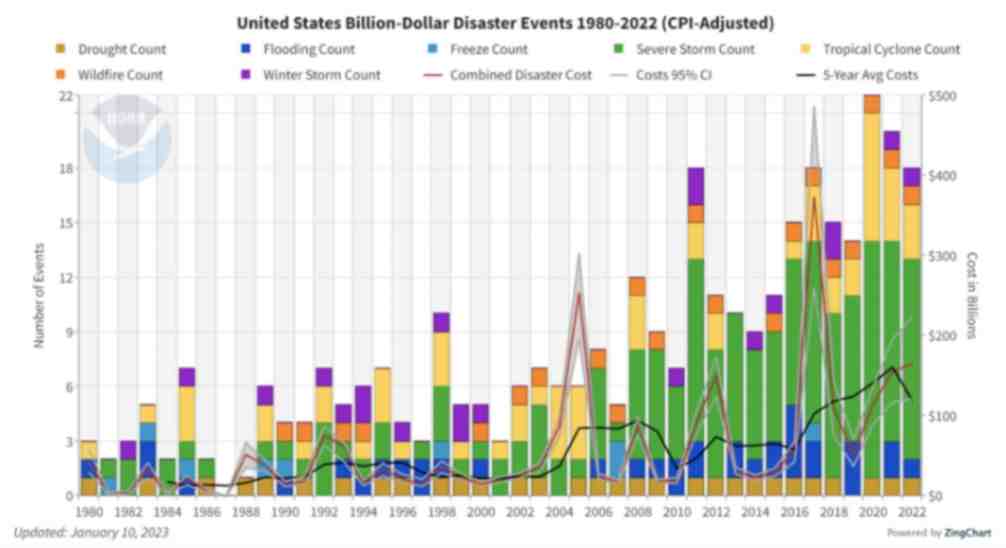
Figure 1. The history of billion-dollar disasters in the United States each year from 1980 to 2022 (source: NOAA)
In terms of loss prevention, a Catastrophe (CAT) Modeling Study is the first step to understanding the exposure and potential financial loss from natural hazards or extreme weather events. CAT studies form the foundation for wider risk management strategies, and have significant implications for insurance costs and coverage.
Despite their importance, developers often view these studies as little more than a formality required for project financing. As a result, they are often conducted late in the development cycle, typically after a site has been selected. However, a strong case can be made for engaging early with an independent third party to perform a more rigorous site-specific technical assessment. Doing so can provide several advantages over traditional assessments conducted by insurance brokerage affiliates, who may not possess the specialty expertise or technical understanding needed to properly apply models or interpret the results they generate. One notable advantage of early-stage catastrophe studies is to help ensure that the range of insurance costs, which can vary from year to year with market forces, are adequately incorporated into the project financial projections.
The evolving threat of natural disasters
Over the past decade, the financial impact of natural hazard events globally has been almost three trillion dollars. In the U.S. alone, the 10-year average annual cost of natural disaster events exceeding $1 billion increased more than fourfold between the 1980s ($18.4 billion) and the 2010s ($84.5 billion).

Investors, insurers, and financiers of renewable projects have taken notice of this trend, and are subsequently adapting their behavior and standards accordingly. In the solar market, for example, insurance premiums increased roughly four-fold from 2019 to 2021. The impetus for this increase can largely be traced back to a severe storm in Texas in 2019, which resulted in an $80 million loss on 13,000 solar panels that were damaged by hail.
The event awakened the industry to the hazards severe storms present, particularly when it comes to large-scale solar arrays. Since then, the impact of convective weather on existing and planned installations has been more thoroughly evaluated during the underwriting process. However, far less attention has been given to the potential for other natural disasters; events like floods and earthquakes have not yet resulted in large losses and/or claims on renewable projects (including wind farms). The extraordinary and widespread effect of the recent Canadian wildfires may alter this behavior moving forward.
A thorough assessment, starting with a CAT study, is key to quantifying the probability of their occurrence — and estimating potential losses — so that appropriate measures can be taken to mitigate risk.
All models are not created equal
Industrywide, certain misconceptions persist around the use of CAT models to estimate losses from an extreme weather event or natural disaster.
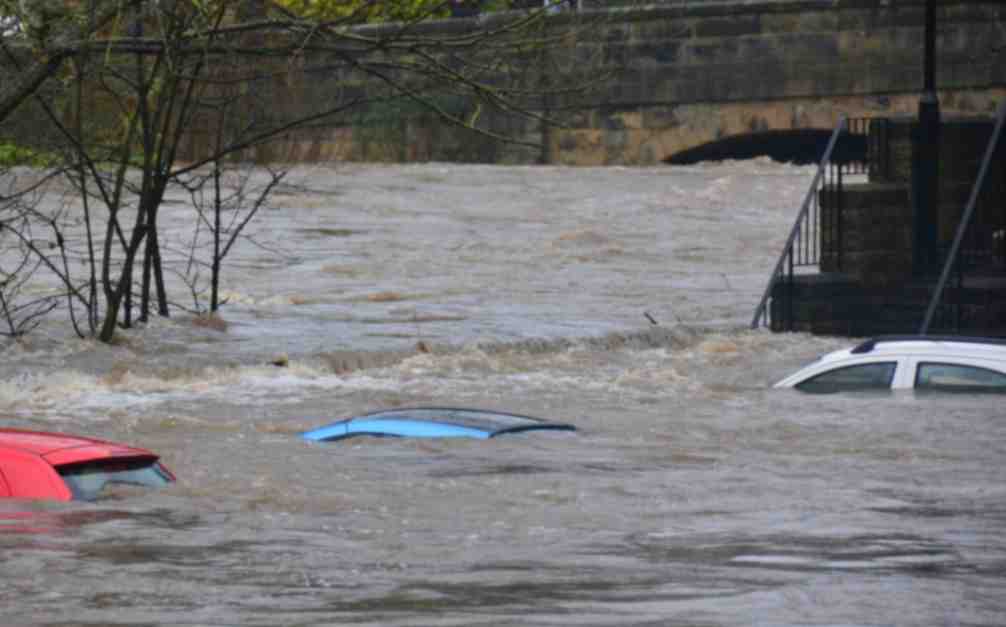
Often, the perception is that risk assessors only need a handful of model inputs to arrive at an accurate figure, with the geographic location being the most important variable. While it’s true that many practitioners running models will pre-specify certain project characteristics regardless of the asset’s design (for example, the use of steel moment frames without trackers for all solar arrays in a given region or state), failure to account for even minor details can lead to loss estimates that are off by multiple orders of magnitude.
The evaluation process has recently become even more complex with the addition of battery energy storage. Relative to standalone solar and wind farms, very little real-world experience and data on the impact of extreme weather events has been accrued on these large-scale storage installations. Such projects require an even greater level of granularity to help ensure that all risks are identified and addressed.
Even when the most advanced modeling software tools are used (which allow for thousands of lines of inputs), there is still a great deal that is subject to interpretation. If the practitioner does not possess the expertise or technical ability needed to understand the model, the margin for error can increase substantially. Ultimately, this can lead to overpaying for insurance. Worse, you may end up with a policy with insufficient coverage. In both cases, the profitability of the asset is impacted.
Supplementing CAT studies
In certain instances, it may be necessary to supplement CAT models with an even more detailed analysis of the individual property, equipment, policies, and procedures. In this way, an unbundled risk assessment can be developed that is tailored to the project. Supplemental information (site-specific wind speed studies and hydrological studies, structural assessment, flood maps, etc.) can be considered to adjust vulnerability models.
This provides an added layer of assurance that goes beyond the pre-defined asset descriptions in the software used by traditional studies or assessments. By leveraging expert elicitations, onsite investigations, and rigorous engineering-based methods, it is possible to discretely evaluate asset-specific components as part of the typical financial loss estimate study: this includes Normal Expected Loss (NEL), also known as Scenario Expected Loss (SEL); Probable Maximum Loss (PML), also known as Scenario Upper Loss (SUL); and Probabilistic Loss (PL).
Understanding the specific vulnerabilities and consequences can afford project stakeholders unique insights into quantifying and prioritizing risks, as well as identifying proper mitigation recommendations.
Every project is unique
The increasing frequency and severity of natural disasters and extreme weather events globally is placing an added burden on the renewable industry, especially when it comes to project risk assessment and mitigation. Insurers have signaled that insurance may no longer be the main basis for transferring risk; traditional risk management, as well as site and technology selection, must be considered by developers, purchasers, and financiers.
As one of the first steps in understanding exposure and the potential capital loss from a given event, CAT studies are becoming an increasingly important piece of the risk management puzzle. Developers should treat them as such by engaging early in the project lifecycle with an independent third-party practitioner with the specialty knowledge, tools, and expertise to properly interpret models and quantify risk.
Hazards and potential losses can vary significantly depending on the project design and the specific location. Every asset should be evaluated rigorously and thoroughly to minimize the margin for error, and maximize profitability over its life.
 Chris LeBoeuf is Global Head of the Extreme Loads and Structural Risk division of ABS Group, based in San Antonio, Texas. He leads a team of more than 60 engineers and scientists in the US, UK, and Singapore, specializing in management of risks to structures and equipment related to extreme loading events, including wind, flood, seismic and blast. Chris has more than 20 years of professional experience as an engineering consultant, and is a recognized expert in the study of blast effects and blast analysis, as well as design of buildings. He holds a Bachelor of Science in Civil Engineering from The University of Texas at San Antonio, and is a registered Professional Engineer in 12 states.
Chris LeBoeuf is Global Head of the Extreme Loads and Structural Risk division of ABS Group, based in San Antonio, Texas. He leads a team of more than 60 engineers and scientists in the US, UK, and Singapore, specializing in management of risks to structures and equipment related to extreme loading events, including wind, flood, seismic and blast. Chris has more than 20 years of professional experience as an engineering consultant, and is a recognized expert in the study of blast effects and blast analysis, as well as design of buildings. He holds a Bachelor of Science in Civil Engineering from The University of Texas at San Antonio, and is a registered Professional Engineer in 12 states.
ABS Group | www.abs-group.com

Grid modernization is having a profound impact on the nature and regulation of North American utilities. It represents a significant change to the way energy is managed, distributed, and used—today and in the future. As Environmental, Social, and Governance (ESG) targets become increasingly important to energy investors and regulators, how can organizations transform their Asset Investment Planning (AIP) processes to overcome challenges and take advantage of emerging opportunities?
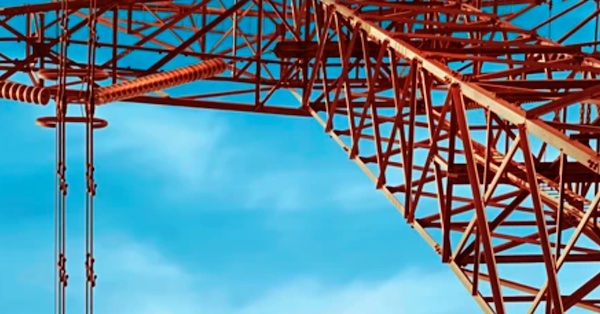
Grid modernization
The energy transition refers to the global energy sector’s shift from fossil-based systems of energy production and consumption to renewable energy sources like wind and solar, as well as long-term energy storage such as batteries. The increasing penetration of renewable energy into the energy supply mix and the onset of electrification and improvements in energy storage are key drivers of the energy transition.
Grid modernization is a subset of the energy transition, and refers to changes needed in the electric transmission and distribution (T&D) systems to accommodate these rapid and innovative technological changes. Grid modernization often necessitates the increased application of sensors, computers, and communications to increase the intelligence of the grid and its ability to respond swiftly to external factors. The main goals of the grid are to provide the capacity, reliability, and flexibility needed to adapt to a whole range of new technologies (in the drive to net zero), while maintaining a comparable level of service and cost to the end customer.
Grid modernization projects are driven by both climate resilience through hardening of assets and changes to the T&D network to accommodate climate mitigation strategies. There are 3 broad categories for these types of projects:
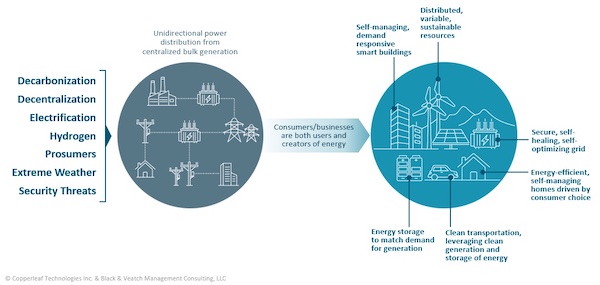
Grid modernization is accelerating due to multiple factors, such as decarbonization, electrification, extreme weather, and security threats.
Valuing innovative projects
The changing demands dictated by grid modernization will require organizations to strike the right balance between cost-effectively managing the current business, while investing appropriately to meet future demands. Organizations are already seeing an increase in both the volume and variety of grid modernization projects. This is leading to increased planning complexity, requiring utilities to demonstrate that they are spending their limited budgets and resources to maximize value and drive their ESG and performance targets.
A value-based approach to investment decision making is key to establishing a common basis to evaluate potential investment opportunities and meet the challenges of grid modernization. The key to achieving your organization’s grid modernization goals is building a multi-year plan that breaks the work into executable chunks. This ensures adequate funding and resources are available to carry out the plan in the short-term, resulting in incremental progress toward longer-term objectives.
With a value-based decision-making approach, organizations can ensure they are making the right grid modernization investments—and justify their plans to internal and external stakeholders.
Align decisions with strategic objectives
Business leaders must develop frameworks that quantify the financial and non-financial benefits of all proposed investments on a common scale and understand how projects will contribute to their short- and long-term grid modernization initiatives and broader energy transition goals. A value framework also creates a clear line of sight from planned investments to regulatory and corporate targets, allowing organizations to provide transparency into the decision-making methodology—and demonstrate the benefits of their plans to regulators, stakeholders, and customers:
 Russ is a Director of Product Management, Decision Analytics at Copperleaf. He is an innovative leader with over 20 years of comprehensive business and technical experience in high-tech product development organizations. Russ holds a B.A.Sc. in Mechanical Engineering from the University of British Columbia and a Management of Technology MBA from Simon Fraser University.
Russ is a Director of Product Management, Decision Analytics at Copperleaf. He is an innovative leader with over 20 years of comprehensive business and technical experience in high-tech product development organizations. Russ holds a B.A.Sc. in Mechanical Engineering from the University of British Columbia and a Management of Technology MBA from Simon Fraser University.
Copperleaf | www.copperleaf.com
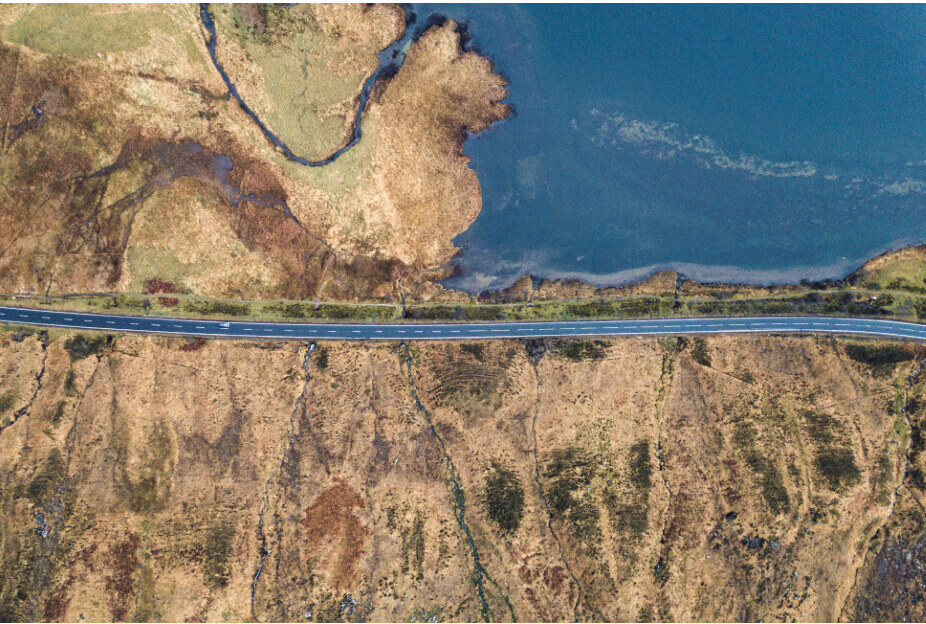
What’s underneath the surface of the land that you plan to develop and who owns it? Identifying owners of mineral rights is critical for utility-scale solar energy projects, especially in regions where these rights are legally separable from surfac....

Since the passage of the Inflation Reduction Act nearly two years ago, U.S. solar panel makers navigate a promising market amid production, legal, and investment considerations Nearly two years after U.S. President Joe Biden signed the Inflation R....
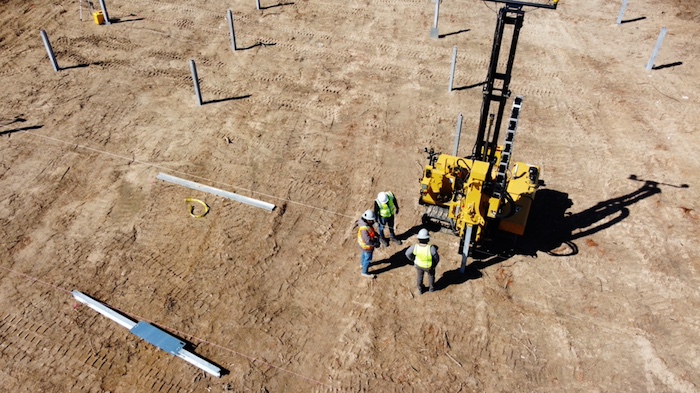
The global shift towards clean energy — exemplified by the widespread adoption of solar power — is not only a beacon of hope for a sustainable future, but also comes with heightened expectations for responsible project execution. From the initial....
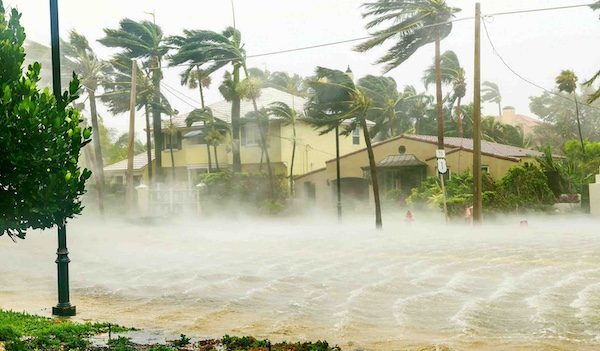
The impacts of climate change are becoming increasingly more apparent as communities around the world experience extreme weather events. From hurricanes and floods to droughts and wildfires, these types of events can have profound negatives effects o....
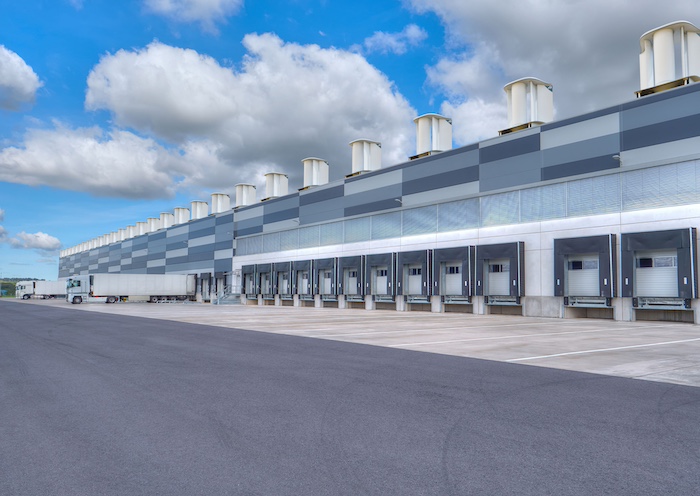
When thinking of renewable energy sources, you most likely picture solar panels or massive wind turbines, churning out energy to reduce the strain on electric grids and helping towns and businesses meet lofty sustainability goals. However, when an ex....
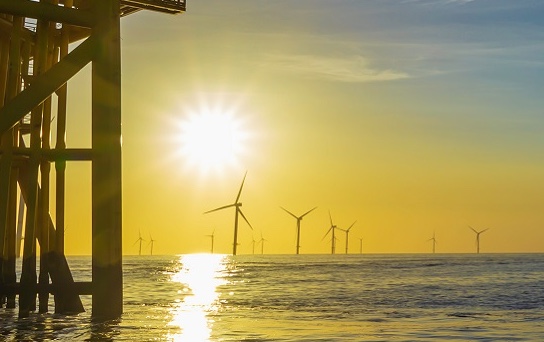
The US offshore wind sector has entered 2024 with cautious optimism as the industry shakes off negativity from last year, ready to apply learnings from a challenging 2023 to the year ahead. There are already key projects in the pipeline, including th....

As the world accelerates its transition to renewable energy sources, the deployment of energy storage solutions has surged to meet the demands of this ongoing transformation. Battery Energy Storage System (BESS) capacity is likely to quintuple betwee....

On April 19, 2019, a thermal runaway event took place in a battery energy storage unit (ESS) located within a building in Surprise, Arizona. The ESS was provided with fire detection and fire suppression, which both activated. Approximately five hours....
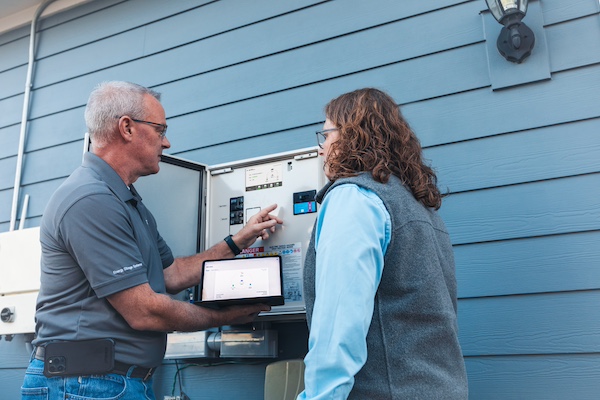
The summer of 2023 was the hottest in recorded history, hitting the United States with disproportionate force. A climatology report by PBS explained that the terrain in and surrounding the U.S. contributes to powerful competing air masses t....
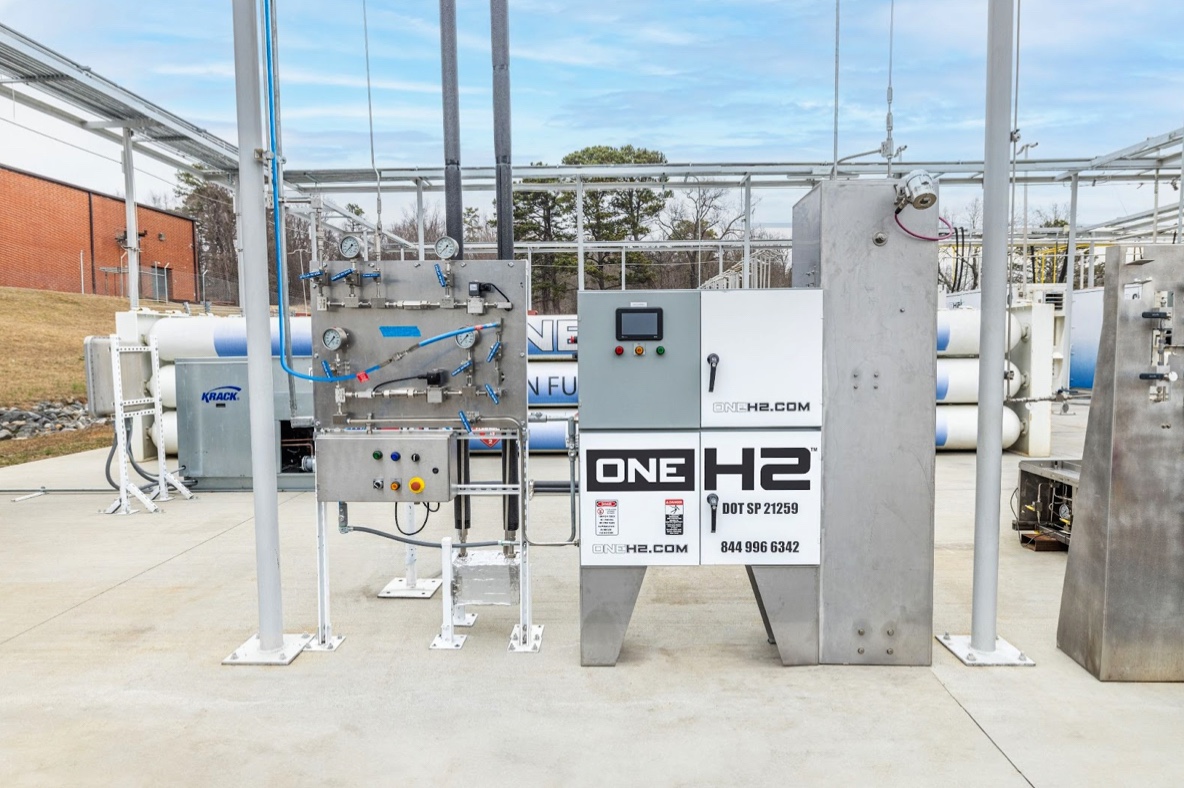
As industrial operations look for opportunities to decrease their carbon emissions, hydrogen fuel cell vehicles and battery-electric vehicles have emerged as potential solutions. These power options generate zero carbon emissions at the tai....

In the last five years, North America has experienced a significant increase in severe weather events that have impacted power grids. In Canada, Alberta's electric system operator issued 17 provincial grid alerts since 2021, due to extreme weather co....

Now more than ever, it would be difficult to overstate the importance of the renewable energy industry. Indeed, it seems that few other industries depend as heavily on constant and rapid innovation. This industry, however, is somewhat unique in its e....